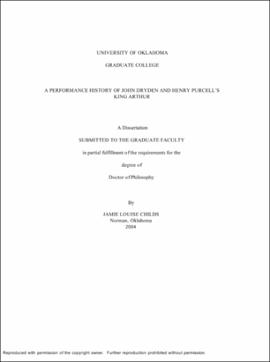| dc.contributor.advisor | Yoch, James, | en_US |
| dc.contributor.author | Childs, Jamie Louise. | en_US |
| dc.date.accessioned | 2013-08-16T12:19:34Z | |
| dc.date.available | 2013-08-16T12:19:34Z | |
| dc.date.issued | 2004 | en_US |
| dc.identifier.uri | https://hdl.handle.net/11244/807 | |
| dc.description.abstract | Primary source documents considered in this study are Dryden's text published in 1691 and reprinted in 1695, and several manuscript scores by Purcell dating from the 1690's and very early 1700's. Additionally, a notated choreography by dance master, Josias Priest, the choreographer for King Arthur , is evaluated, as are several descriptive accounts of his dancing by his contemporaries. Playbooks and scores for later revivals are also valuable as primary sources. Secondary source documents include theatrical records, journalistic commentaries and reviews of the earliest and subsequent performances of King Arthur, as well as more recent treatises that deal with theatrical, dramatic, and musical conventions of the Restoration era and the eighteenth through twentieth centuries. | en_US |
| dc.description.abstract | "A Performance History of John Dryden and Henry Purcell's King Arthur" traces the development of an exemplary dramatic opera of the Baroque era through more than three hundred years of adaptations and revivals. Co-authored by a major English poet of the late seventeenth century, John Dryden, and the most important English composer of the time, Henry Purcell, King Arthur was first published and performed in 1691 or early 1692. This dramatic opera, or semi-opera, represents a pre-eminent performance genre of the era; the study-at-hand investigates this genre, and King Arthur's place within it, then pursues its life from its origin until its latest performance within the last several years. Such a performance history reveals the cultural contexts of its many revivals through a close examination of the aspects of its text, music, dance, and stage production. | en_US |
| dc.description.abstract | The plays of John Dryden have frequently been analyzed for aspects of empiricism, political partisanship, issues of colonialism and even gender; however, the musical portions of his dramas have received less attention from researchers of his works. And while Purcell's theatrical music has been considered for its place within Dryden's dramatic productions, as well as within Purcell's own stylistic development, "A Performance History of... King Arthur" goes further to present the full evolution of three hundred years of performance practices and audience receptions to this multi-faceted and adaptable operatic entertainment. Thus, this study endeavors to create a broad understanding of cultural standards and theatrical traditions from the earliest Baroque-era productions of King Arthur until our time. | en_US |
| dc.format.extent | x, 120 leaves : | en_US |
| dc.subject | Music. | en_US |
| dc.subject | Theater. | en_US |
| dc.subject | Theater Research. | en_US |
| dc.subject | Purcell, Henry, 1659-1695. King Arthur. | en_US |
| dc.subject | Priest, Josias, d. 1734. | en_US |
| dc.subject | Dryden, John, 1631-1700. | en_US |
| dc.title | A performance history of John Dryden and Henry Purcell's "King Arthur". | en_US |
| dc.type | Thesis | en_US |
| dc.thesis.degree | Ph.D. | en_US |
| dc.thesis.degreeDiscipline | Department of English | en_US |
| dc.note | Adviser: James Yoch. | en_US |
| dc.note | Source: Dissertation Abstracts International, Volume: 65-09, Section: A, page: 3209. | en_US |
| ou.identifier | (UMI)AAI3148980 | en_US |
| ou.group | College of Arts and Sciences::Department of English | |
